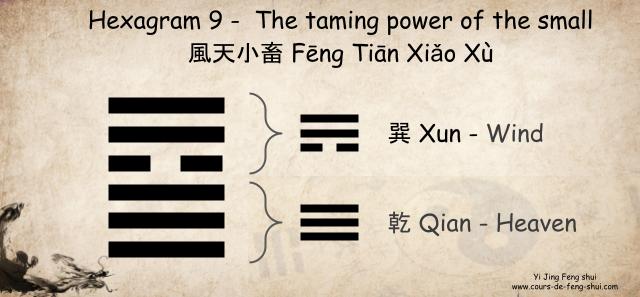
Hexagram 9 of the Yi Jing is composed of the upper trigram ☴ 巽 Xun (Wind, the eldest daughter) and the lower trigram ☰ 乾 Qian (Heaven, the father).
In Chinese: 風天小畜 Fēng Tiān Xiǎo Chù, the English translation is “Taming the Little One.”
Interpretation from comments: Weak gathering, a time when energies do not allow for great achievements.
Jia Zi combination of the hexagram: Hexagram 9 of the I Ching is associated with 丁巳 Ding Si, the 54th combination of the sexagesimal cycle (hour, day, month, year):
- 丁 Ding, celestial stem Fire Yin
- 巳 Si, terrestrial branch of the Serpent
Interpretation of the drawing of hexagram 9 of the I Ching
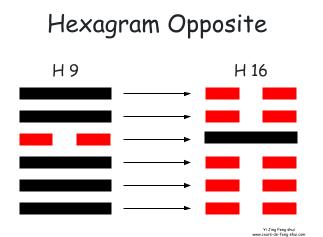
Opposite hexagram (錯卦 Cuo Gua): The opposite hexagram indicates everything that is not or the opposite of the solution to the situation.
The opposite hexagram is obtained by replacing the Yang lines with Yin lines and vice versa, resulting in Hexagram 16 – |Enthusiasm.
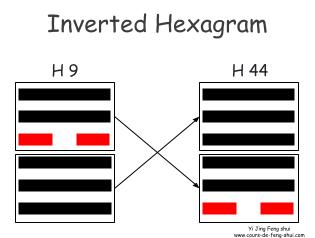
Inverted Hexagram (覆卦 Fu Gua): The permuted hexagram provides information on the origin of the situation.
The permuted hexagram is obtained by swapping the two trigrams, resulting in Hexagram 44 – Gou (Coming to Meet).
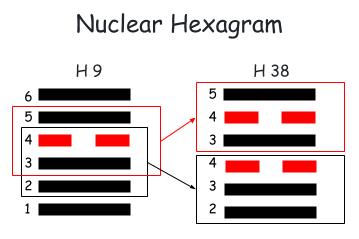
Nuclear Hexagram (互卦 Hu Gua): The nuclear hexagram represents the core of the problem or question.
The nuclear hexagram is obtained by using the four central lines to form two trigrams, resulting in Hexagram 38 – Kui (Opposition).
Mutant Hexagram (derived): The mutation of a line results in a new hexagram, which indicates the evolution of the situation.
- Line 6 mutates: the resulting hexagram is H5.
- Line 5 mutates: the resulting hexagram is H26.
- Line 4 mutates: the resulting hexagram is H1.
- Line 3 mutates: the resulting hexagram is H61.
- Line 2 mutates: the resulting hexagram is H37.
- Line 1 mutates: the resulting hexagram is H57.
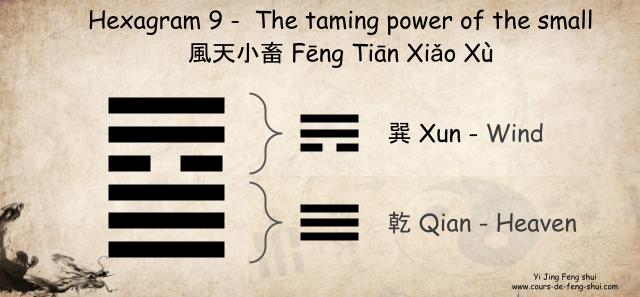
Taoist Yi Jing – Wen Wang Gua
Characteristics of hexagram 9 for the Taoist interpretation of the Yi Jing using the Wen Wang Gua (Liu yao) divination method:
Hexagram 9 is from Generation 1 of the Xun family (Wood). In this hexagram, the Subject is placed on the first line, and the Object is placed on the fourth line.
The Six Relatives:
- 6th line: 卯 Mao (Wood) – Brothers
- 5th line: 巳 Si (Fire) – Children
- 4th line: 未 Wei (Earth) – Wealth
- 3rd line: 辰 Chen (Earth) – Wealth
- 2nd line: 寅 Yin (Wood) – Brothers
- 1st line: 子 Zi (Water) – Parents